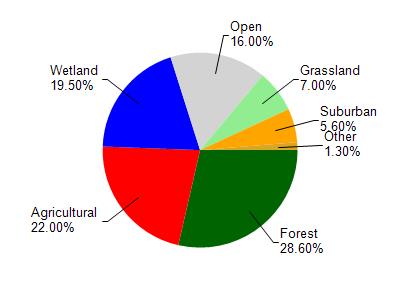Menominee
No
No
No
Fish and Aquatic Life
Overview
A soft water seepage lake having alkaline, turbid water of very low transparency. Littoral material consists of muck. A hardwood upland shore line is found along most of the lake shore although a narrow meadow wetland fringe lies between the upland and lake. Two small pockets of tamarack swamp lie on the north and east shore. Lake level is subject to some natural variation and during the 1930's dried up completely. Due to its shallow depth and indications of possible winterkill, the lake is not suited for fish management other then forage species. Waterfowl make moderate use of this lake on their fall migration. No developments are located on the shore line. An old company logging road lies within a few hundred feet of the lake.
Coon Lake - T-28-N, R-16-E, Section 25
Surface Area = 29.6 acres, S.D.F. = 1.24, Maximum Depth - 5 feet
Source: 1963, Surface Water Resources of Menominee County
Date 1963
Author Aquatic Biologist
Condition
Wisconsin has over 84,000 miles of streams, 15,000 lakes and milllions of acres of wetlands. Assessing the condition of this vast amount of water is challenging. The state's water monitoring program uses a media-based, cross-program approach to analyze water condition. An updated monitoring strategy (2015-2020) is now available. Compliance with Clean Water Act fishable, swimmable standards are located in the Executive Summary of Water Condition in 2018. See also the 'monitoring and projects' tab.
Reports
Management Goals
Wisconsin's Water Quality Standards provide qualitative and quantitative goals for waters that are protective of Fishable, Swimmable conditions [Learn more]. Waters that do not meet water quality standards are considered impaired and restoration actions are planned and carried out until the water is once again fishable and swimmable
Management goals can include creation or implementation of a Total Maximum Daily Load analysis, a Nine Key Element Plan, or other restoration work, education and outreach and more. If specific recommendations exist for this water, they will be displayed below online.
Monitoring
Monitoring the condition of a river, stream, or lake includes gathering physical, chemical, biological, and habitat data. Comprehensive studies often gather all these parameters in great detail, while lighter assessment events will involve sampling physical, chemical and biological data such as macroinvertebrates. Aquatic macroinvertebrates and fish communities integrate watershed or catchment condition, providing great insight into overall ecosystem health. Chemical and habitat parameters tell researchers more about human induced problems including contaminated runoff, point source dischargers, or habitat issues that foster or limit the potential of aquatic communities to thrive in a given area. Wisconsin's Water Monitoring Strategy was recenty updated.
Grants and Management Projects
| Project Name (Click for Details) | Year Started |
|---|
|
|
Monitoring Projects
| WBIC | Official Waterbody Name | Station ID | Station Name | Earliest Fieldwork Date | Latest Fieldwork Date | View Station | View Data |
|---|
| 183600 | Coon Lake | 10003956 | Coon Lake | 7/27/1999 | 7/15/2015 | Map | Data |
|

Watershed Characteristics
Coon Lake is located in the Shawano Lake watershed which is 71.16 mi². Land use in the watershed is primarily forest (28.60%), agricultural (22%) and a mix of wetland (19.50%) and other uses (29.90%). This watershed has 76.28 stream miles, 7,438.74 lake acres and 7,573.91 wetland acres.
Nonpoint Source Characteristics
This watershed is ranked Not Ranked for runoff impacts on streams, High for runoff impacts on lakes and High for runoff impacts on groundwater and therefore has an overall rank of High. This value can be used in ranking the watershed or individual waterbodies for grant funding under state and county programs.However, all waters are affected by diffuse pollutant sources regardless of initial water quality. Applications for specific runoff projects under state or county grant programs may be pursued. For more information, go to surface water program grants.